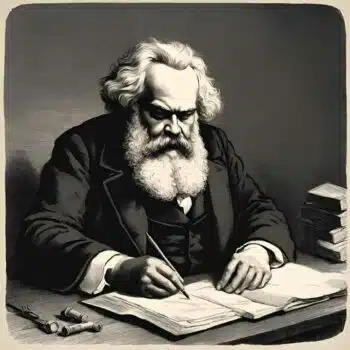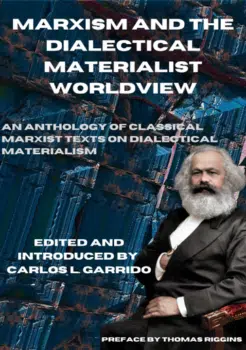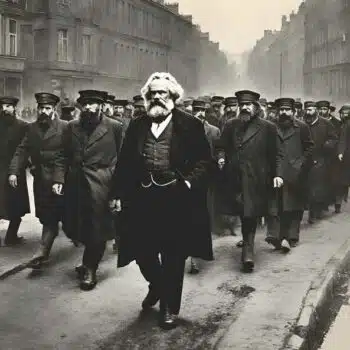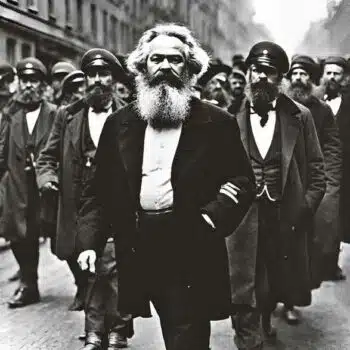Dialectical Materialist Ontology

Objective dialectics, i.e., the dialectical materialist ontology, first and foremost holds that the world is dominated by change and interconnection, “nothing is eternal but eternally changing.”4 It acknowledges that “movement is itself a contradiction,” and that “contradiction propels movement.”5 These are the basic premises of dialectics pertaining to the ontological constitution of the world. It is important to note, however, that these central premises make it an ontology of becoming, not being. Insofar as being is understood as an unchanging, pure, universal substratum, it is rejected as an explanatory category. If being, however, is understood as a constant “coming-to-be and ceasing-to-be,” that is, if it is understood as becoming, then it can be sustained as a foundational category in a dialectical materialist ontology.6 Nonetheless, as Hegel noted, although “the first truth is to be found in becoming,” this first concrete category is still an abstract first step which gives way to a more concrete understanding of the world.7 If we stop here, then, we have merely achieved the position of Greek (more specifically Heraclitan) dialectics mentioned above. Although, as Engels said, “the new age begins with the return to the Greeks—negation of the negation,” this return is mediated by half a millennium of metaphysically framed scientific studies,8 and therefore, it is not a return to the same Greek dialectic, but to a richer (more concrete) one.9 Hence, what is required is not just the understanding that everything is in constant motion and interconnection, driven by internal contradictory forces, but a concrete understanding of the mechanisms and structures through which these changes occur.
The dialectical materialist ontology, as an ontology of becoming, is concerned with the “most general laws” of human and natural “historical development” and “of thought itself.”10 Marx and Engels both agreed that these laws had already been discovered by Hegel, but in a mystified form. For instance, Marx says in a letter to Dietzgen that “The true laws of dialectics are already contained in Hegel, though in a mystical form,” and Engels similarly repeats this by saying that “all three [laws of dialectics] are already developed by Hegel… [but] foisted on nature and history as laws of thought, and not deduced from them.”11 These ‘laws’ are 1) the unity and struggle of opposites, 2) the transition from quantity into quality and vice versa, and 3) the negation of the negation. It is important to note that Hegel never referred to them as ‘laws’; in his Logic[s] they are merely categories, little different than the plethora of other categories his logical unfolding of the concept introduces. However, the reason behind Marx and Engels’ classification of these Hegelian categories as ‘laws’ lies in the fact they can be seen in every ‘moment’ of the movement of Hegel’s concept, and most importantly, because Marx and Engels ‘re-discover’ them in the movement and interconnection of nature and society and postulate their objective existence as the source for their reflective (subjective) existence in the mind. These three dialectical laws, by being the most universal forms in which change occurs, are also the most abstract, and hence, serve as the base upon which a more concrete understanding of change and interconnection in smaller or larger organic totalities can take place.
It is here where the accusations of simplifying dialectics usually begin. Once these three laws are established, it becomes a game of examples, whoever can fit the schema of these laws on nature, human society, history, or thinking the most wins. In treating these laws as a “sum total of examples,” Lenin argued, “dialectics usually receives inadequate attention.”12 For Lenin the architype for this was Plekhanov, although at times, he argued, “the same is true of Engels.”13 To be clear, the problem is not the examples in themselves, but when dialectics is en toto reduced to a collection of examples. When this reduction takes place, Chris Arthur is right to say that dialectics turns into a “lifeless formalism” which proceeds by “applying abstract schemas adventitiously to contents arbitrarily forced into the required shape.”14 However, one must not confuse this vulgarization of dialectics to mean that one cannot provide examples in nature, society, or thinking that confirm these laws. Like we saw in the previous section, one can hold onto Marxism as a weltanschauung and simultaneously reject vulgarizations of this weltanschauung. Similarly, one can reject the reduction of dialectics to a basket of artificially foisted examples but still use examples to understand objective dialectics. After all, the central difference between the Hegelian and Marxist dialectics is the latter’s materialist position that dialectics is the ontological condition of the world, and only when this world is concretely understood does dialectical thinking emerge. It is necessary, then, to use concrete examples from the world to understand the world itself, and hence, grasp objective dialectics subjectively.

It is this context in which Engels deduces the dialectical laws in his scientific studies, and Marx in his economic studies. The examples they provide are concrete, and (esp. in the case of Engels) usually include comments on how science already accepted (in certain fields) these ‘laws’ but under different names. For instance, in Engels’ letter to Friedrich Albert Lange, he argues that the “modern scientific doctrine of reciprocity of natural forces [is] just another expression or rather the positive proof of the Hegelian development on cause & effect, reciprocity, force, etc.”15 Let me now provide a few concrete examples in which these most general laws of change and interconnection can be observed. Recall that by being the ‘most general’ they are also the most abstract, and hence, each example is in itself insufficiently understood if the only thing one says is how one or another of these dialectical laws is observed in it. To be concretely understood, each of these examples must take the structural appearance of the laws as a mere starting point to the investigation of the phenomenon. The laws work like the study of a townhouse community; by knowing how the outside of each townhouse looks, one has grasped the most general fact in the community. This ‘most general’ fact can then serve as the abstract starting point for the concrete study of the internal structural differences in each household. One cannot claim to know the community by simply knowing the ‘most general’ fact, and similarly, by only knowing the differences in each household one is blind to the ‘most general’ fact that the object of one’s study is not independent houses, but a townhouse community.
The Three Ontological Laws of Dialectics in Political Economy
“The most important aspect of dialectics,” Hegel argued, is the “grasping of opposites in their unity.”16 Similarly, Marx would say in Capital Vol. I that the “Hegelian contradiction [is] the source of all dialectic.”17 Lenin would repeat this by saying that “the division of a unity into two and the cognition of its contradictory parts is the essence of dialectics.”18 It is thus, with the law of the unity and struggle of opposites that we must begin, for the “condition for the knowledge of all processes in the world in their ‘self-movement,’ in their spontaneous development, in their real life, is the knowledge of them as a unity of opposites.”19 It is this law which allows the understanding of the other two, for not only does it “furnish the key to the ‘self-movement’ of everything that exists; it alone furnishes the key to the ‘leaps,’ to the ‘interruption of gradualness,’ to the ‘transformation into the opposite,’ to the destruction of the old and the emergence of the new.”20 Let us now see how Marx observes the functioning of this law in the realm of political economy.

In all the contradictions of capitalist production as a whole we have lucid examples of the law of the unity and struggle of opposites, and, as Marx adds, “the most abstract forms are recurring and are contained in the more concrete forms.”28 In regard to social class, for instance, the capitalist mode of life is marked by the contradiction between the working and the capitalist class. These two classes are both struggling amongst themselves and in unity under capitalism, that is, capitalism contains—not externally, but in itself—two opposing forces whose struggle shapes its development. As Lenin argued, once the understanding of the unity and struggle of opposites is grasped, we are ‘furnished’ with the keys to understand the other laws of movement.
The law of the unity and struggle of opposites, or what is the same, the law of the universality of contradictions, would be enriched by Mao Tsetung’s 1937 essay “On Contradiction.” Here, Mao develops important categories relating to the particularity of contradictions, further concretizing the dialectical materialist ontology and its ability to understand the concrete concretely. The first important categorial development is the notion of principal and secondary contradictions. As Mao notes, “there are many contradictions in the process of development of a complex thing, and one of them is necessarily the principal contradiction whose existence and development determine or influence the existence and development of the other contradictions.”29 It becomes an imperative, therefore, to “devote every effort to finding [the] principal contradiction” in whatever complex process one is studying, for “once this principal contradiction is grasped, all problems can be readily solved.”30 Likewise, Mao notes that in any contradiction, i.e., in any unity of opposites, there is always one antipole which is dominant. This is what he calls the principal aspect of a contradiction, it refers to the “aspect which has gained the dominant position.”31 This dominant position is not static, but always subject to change; what is the principal aspect in one moment may turn into the non-principal aspect in another.
Additionally, Mao refines the law of the unity and struggle of opposite by recapturing a distinction Lenin had already noted between antagonisms and contradictions. Lenin argued that “antagonism and contradiction are not at all one and the same… under socialism, the first will disappear, the second will remain.”32 Mao clarifies this by showing that “antagonism is one form, but not the only form, of the struggle of opposites.”33 Class societies are bound, sooner or later, to develop “the form of open antagonism” which shifts the class struggle into a moment of revolution.34 In Gramscian terms, these are the moments when the emphasis is switched from the war of position (the battle for hegemony) to the war of maneuver, where the opposites engage in direct frontal attacks. Sometimes non-antagonistic contradictions develop into antagonistic ones, and likewise, antagonistic contradictions develop into non-antagonistic ones.35 Contradictions obtain an antagonistic form in moments of explosion, when “open conflict to resolves old contradictions” takes place and new things are produced.36 Recognizing whether a contradiction is antagonistic or not is fundamental to the process of resolving it. For instance, the working and the capitalist class are in an irreconcilable antagonism, one which can only be solved through the working class’s revolutionary overthrow of the capitalist class.

After having grasped the law of the unity and struggle of opposites, and how this general law was concretized by Mao, we may examine the law of the transition from quantity to quality and vice-versa. In the transition from money into capital we have an example of the law of the transformation of quantity into quality. For money to be transformed into capital, that is, into something qualitatively new, surplus-value needs to be created. For this to happen, it is necessary for a specific amount of money to be turned “into commodities that serve as the material element of a new product,” and further, to “incorporate living labor” onto this “dead substance.”37 If the labor-power incorporated creates only the value necessary for the laborer’s subsistence, i.e., if it produces an equivalent to the exchange value it was bought for, then no surplus could be realized. However, what “really influenced” the buyer [i.e., the capitalist] of labor-power was “the specific use-value which this commodity possesses of being a source not only of value, but of more value than it has itself.”38
To create surplus value, and hence, materialize the use value for which the labor-power was bought (viz., to be a source of “more value than it has itself”), that labor power must be extended beyond the time it took it to produce the amount of value it was bought for.39 As Marx says, “if we compare the two processes of producing value and of creating surplus-value, we see that the latter is nothing but the continuation of the former beyond a definite point.”40 This “definite point” is what Hegel call “nodal points” in his Logic[s], it is the moment when “gradual [i.e., quantitative] increase… is interrupted” and the result is “a leap from quantitative into qualitative alteration.”41 The quantitative extension of the working day beyond the time necessary to produce the value the labor-power was bought for is how surplus-value arises. A quantitative accumulation of working hours, at a ‘definite point’ [i.e., nodal point], produces a qualitative leap and surplus-value comes about. Quantitative change has resulted in a leap into something qualitatively different. This qualitative leap into surplus-value, “a process which is entirely confined to the sphere of production,” creates the conditions for the “metamorphosis of money into capital,” another qualitative leap effected by the transcendence of labor-power beyond this ‘nodal point.’42
There is a plethora of other places where the law of the transition of quantity into quality can be observed in Capital. For instance, Marx says that “not every sum of money, or of value, is at pleasure transformable into capital;” a “certain minimum of money or of exchange-value must be pre-supposed in the hands of the individual possessor of money or commodities.”43 This is because there is a nodal point at which the variable capital [i.e., labor-power] involved in production turns the owner into a capitalist proper. “The guilds of the middle ages,” Marx argued, “tried to prevent by force the transformation of the master of a trade into a capitalist, by limiting the number of labourers that could be employed by one master within a very small maximum.”44 This fetter presented in the middle-ages prevented the development of the capitalist proper. Only when this fetter is broken can “the possessor of money or commodities actually turn into a capitalist.”45 This transformation occurs “in such cases only where the minimum sum advanced for production greatly exceeds the maximum of the middle ages.”46 Marx then explicitly says that “here, as in natural science, is shown the correctness of the law discovered by Hegel (in his “Logic”), that merely quantitative differences beyond a certain point pass into qualitative changes.”47

Here we have the clearest depiction, within the lens of universal history, of the law of the negation of the negation. Capitalist private property negates “self-earned private property.”54 It socializes production and creates for the first time ever a “division of labour in the workshop.”55 Its private “mode of appropriation” at a nodal point presents a fetter to the centralized and socialized means of production, immanently creating its own conditions for its sublation [i.e., negation of the negation].56 This is a process which involves the “expropriation of a few usurpers by the mass of the people,” and hence, is expected to be “incomparably [less] protracted, violent, and difficult” than the capitalist negation of feudalism.57
As can be seen from the examples in political economy, these dialectical laws are interconnected. The internal contradiction in all things propels universal movement. At times—in the nodal points mentioned above—this movement breaks its quantitative gradualness and undergoes a qualitative leap. All qualitative leaps are negations of that which has undergone a qualitative transformation. These negations immanently create the conditions for their own negation and bring about, in certain nodal points, a negation of the negation. No negation fully annihilates that which it has negated, part of it is always preserved in the qualitatively new it has unfolded into. For instance, capitalism sustains feudal private property but cancels out feudal individualized production; socialism sustains the socialized production of capitalism but cancels out its privatized accumulation. These are, of course, simple examples; but they are nonetheless helpful pedagogical tools to understand the most general laws of movement and interconnection, and hence, to build the base necessary for knowing more concrete things concretely.
Notes:
- ↩ Henri Lefebvre, Dialectical Materialism (Minneapolis: University of Minnesota, 2009), 95.
- ↩ Georg Lukács, A Defense of History and Class Consciousness: Tailism and the Dialectic (New York: Verso Books, 2000), 30. What is interesting about this affirmation is that for most Marxist scholars, the ‘break’ between ‘western’ and ‘soviet’ Marxism (and hence, the beginning of the ‘Engels debate’) occurs first in Georg Lukács’ famous sixth footnote of the first chapter in his 1923 History and Class Consciousness, where he says that “Engels—following Hegel’s mistaken lead—extended the [dialectical] method also to knowledge of nature.” Instead, argued Lukács, the dialectical method should be limited to “historical-social reality.” What those who have banked on this footnote forget, or are unaware of, is that Lukács comes to reject his own position to the point of “[launching] a campaign to prevent the reprints of his 1923 book.” Lukács had argued that his book was ‘outdated,’ ‘misleading,’ and ‘dangerous’ because “it was written in a ‘transition [period] from objective idealism to dialectical materialism.’” Additionally, he was quite explicit in arguing that “’[his] struggle against… the concept of dialectics in nature’ was one of the ‘central mistakes of [his] book.’” For more see my review of Friedrich Engels and the Dialectic of Nature cited above.
- ↩ Lefebvre, Dialectical Materialism, 95-96.
- ↩ Engels, Dialectics of Nature, 40.
- ↩ Lefebvre, Dialectical Materialism, 28.
- ↩ G. W. F. Hegel, The Science of Logic, translated by A. V. Miller (London: Allen and Unwin, 1969), § 187.
- ↩ G. W. F. Hegel, Lectures on the History of Philosophy (New York: Routledge and Kegan, 1968) 283.
- ↩ I am using ‘metaphysics’ here in the way Engels and Marx do, as a way of analyzing things statically and isolated from the interconnections in which it exists. I must note, however, that this is not the same way metaphysics is defined in the history of philosophy.
- ↩ Engels, Dialectics of Nature, 195.
- ↩ Engels, Dialectics of Nature, 63.
- ↩ Karl Marx, “Marx to Joseph Dietzgen,” May 9, 1868, In Marx-Engels Collected Works Vol 43 (New York: International Publishers, 1988), 31; Engels, Dialectics of Nature, 63.
- ↩ Lenin, Collected Works Vol. 38, 357.
- ↩ Lenin, Collected Works Vol. 38, 357.
- ↩ Chris Arthur, The New Dialectic and Marx’s Capital (London: Brill, 2004), 3.
- ↩ Friedrich Engels, “Engels to Lange,” March 29, 1865. In Marx-Engels Collected Works Vol 42 (New York: International Publishers, 1987), 138.
- ↩ Hegel, Science of Logic, §69.
- ↩ Marx, Capital Vol. 1 (New York: International Publishers, 1974), 596.
- ↩ Lenin, Collected Works Vol 38, 357.
- ↩ Lenin, Collected Works Vol 38, 358.
- ↩ Lenin, Collected Works Vol 38, 358.
- ↩ Lenin, Collected Works Vol 38, 358-359. Lenin uses ‘cell,’ Marx uses ‘cell-form.’
- ↩ Marx, Capital Vol. I, 104.
- ↩ Roslyn Wallach Bologh, Dialectical Phenomenology: Marx’s Method (Boston: Routledge & Kegan Paul, 1979), 64.
- ↩ Lenin, Collected Works Vol 38, 358.
- ↩ Lenin, Collected Works Vol 38, 359.
- ↩ Karl Marx, Capital Vol. III (New York: International Publishers, 1974), 391.
- ↩ Karl Marx, Theories of Surplus Value Vol. II (London: Lawrence & Wishart, 1975), 509, 507.
- ↩ Karl Marx, Theories of Surplus Value Vol. II, 509.
- ↩ Mao Tsetung, “On Contradiction,” In Five Essays on Philosophy (Peking: Foreign Language, 1977) 51.
- ↩ Tsetung, “On Contradiction,” 53.
- ↩ Tsetung, “On Contradiction,” 54.
- ↩ V. I. Lenin, “Remarks on N. I. Bukharin’s Economics of the Transitional Period” Selected Works, Russ. ed., Moscow-Leningrad, 1931, Vol. XI, p. 357.
- ↩ Mao, “On Contradiction,” 68.
- ↩ Tsetung, “On Contradiction,” 69.
- ↩ Tsetung, “On Contradiction,” 70.
- ↩ Tsetung, “On Contradiction,” 69.
- ↩ Marx, Capital Vol. I, 195.
- ↩ Marx, Capital Vol. I, 193.
- ↩ Marx, Capital Vol. I, 193.
- ↩ Marx, Capital Vol. I, 195.
- ↩ G. W. F. Hegel, The Science of Logic, translated by George di Geovanni (Cambridge: Cambridge University Press, 2015), 321-322.
- ↩ Marx, Capital Vol. I, 194-195. This latter transformation requires the surplus-value produced in the moment of production to return to the moment of circulation and realize itself. As Marx says in Capital Vol. III, “industrial capitalist merely realises the previously produced surplus-value, or profit, in the process of circulation.” Marx, Capital Vol. III, 283.
- ↩ Marx, Capital Vol. I, 307-308. This is the example Engels uses in his Anti-Dühring when discussing the law of the transformation of quantity into quality.
- ↩ Marx, Capital Vol. I, 308-309.
- ↩ Marx, Capital Vol. I, 309.
- ↩ Marx, Capital Vol. I, 309.
- ↩ Marx, Capital Vol. I, 309.
- ↩ Marx, Capital Vol. I, 751.
- ↩ Marx, Capital Vol. I, 714, 774.
- ↩ Marx, Capital Vol. I, 715.
- ↩ Marx, Capital Vol. I, 762-763.
- ↩ Marx, Capital Vol. I, 763.
- ↩ Marx, Capital Vol. I, 763.
- ↩ Marx, Capital Vol. I, 774.
- ↩ Marx, Capital Vol. I, 359. “Division of labour in the workshop, as practices by manufacture, is a special creation of the capitalist mode of production alone.”
- ↩ Marx, Capital Vol. I, 763
- ↩ Marx, Capital Vol. I, 764.
Carlos L. Garrido is a Cuban American philosophy instructor at Southern Illinois University, Carbondale. He is the director of the Midwestern Marx Institute and the author of The Purity Fetish and the Crisis of Western Marxism (2023), Marxism and the Dialectical Materialist Worldview (2022), and the forthcoming Hegel, Marxism, and Dialectics (2024). He has written for dozens of scholarly and popular publications around the world and runs various live-broadcast shows for the Midwestern Marx Institute YouTube. You can subscribe to his Philosophy in Crisis Substack <.substack.com/”>HERE.

